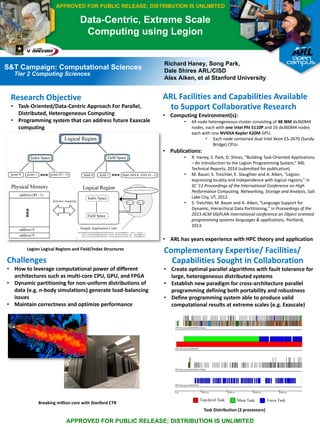Report
Share
Download to read offline

Recommended
Recommended
More Related Content
What's hot
What's hot (13)
Gray-Box Models for Performance Assessment of Spark Applications

Gray-Box Models for Performance Assessment of Spark Applications
Application-Aware Big Data Deduplication in Cloud Environment

Application-Aware Big Data Deduplication in Cloud Environment
Claremont Report on Database Research: Research Directions (Anastasia Ailamaki)

Claremont Report on Database Research: Research Directions (Anastasia Ailamaki)
Quantifying Uncertainty in Agent-Based Models for Smart City Forecasts

Quantifying Uncertainty in Agent-Based Models for Smart City Forecasts
Twister4Azure - Iterative MapReduce for Azure Cloud

Twister4Azure - Iterative MapReduce for Azure Cloud
Similar to CS7_HANEY_DataCentricExtremeScaleComputLegion PAO edit
Similar to CS7_HANEY_DataCentricExtremeScaleComputLegion PAO edit (20)
Exascale Computing Project - Driving a HUGE Change in a Changing World

Exascale Computing Project - Driving a HUGE Change in a Changing World
Scientific Application Development and Early results on Summit

Scientific Application Development and Early results on Summit
Matching Data Intensive Applications and Hardware/Software Architectures

Matching Data Intensive Applications and Hardware/Software Architectures
Matching Data Intensive Applications and Hardware/Software Architectures

Matching Data Intensive Applications and Hardware/Software Architectures
NASA Advanced Computing Environment for Science & Engineering

NASA Advanced Computing Environment for Science & Engineering
09 The Extreme-scale Scientific Software Stack for Collaborative Open Source

09 The Extreme-scale Scientific Software Stack for Collaborative Open Source
How to Design Scalable HPC, Deep Learning, and Cloud Middleware for Exascale ...

How to Design Scalable HPC, Deep Learning, and Cloud Middleware for Exascale ...
Evolving Cyberinfrastructure, Democratizing Data, and Scaling AI to Catalyze ...

Evolving Cyberinfrastructure, Democratizing Data, and Scaling AI to Catalyze ...
Overview of the Exascale Additive Manufacturing Project

Overview of the Exascale Additive Manufacturing Project
Exploring emerging technologies in the HPC co-design space

Exploring emerging technologies in the HPC co-design space
Designing HPC & Deep Learning Middleware for Exascale Systems

Designing HPC & Deep Learning Middleware for Exascale Systems
More from Richard Haney
More from Richard Haney (6)
CS7_HANEY_DataCentricExtremeScaleComputLegion PAO edit
- 1. Data-Centric, Extreme Scale Computing using Legion Richard Haney, Song Park, Dale Shires ARL/CISD Alex Aiken, et al Stanford University S&T Campaign: Computational Sciences Tier 2 Computing Sciences Research Objective • Task-Oriented/Data-Centric Approach For Parallel, Distributed, Heterogeneous Computing • Programming system that can address future Exascale computing Challenges • How to leverage computational power of different architectures such as multi-core CPU, GPU, and FPGA • Dynamic partitioning for non-uniform distributions of data (e.g. n-body simulations) generate load-balancing issues • Maintain correctness and optimize performance Breaking million core with Stanford CTR ARL Facilities and Capabilities Available to Support Collaborative Research • Computing Environment(s): • 64 node heterogeneous cluster consisting of 48 IBM dx360M4 nodes, each with one Intel Phi 5110P and 16 dx360M4 nodes each with one NVIDIA Kepler K20M GPU. • Each node contained dual Intel Xeon E5-2670 (Sandy Bridge) CPUs • Publications: • R. Haney, S. Park, D. Shires, “Building Task-Oriented Applications – An Introduction to the Legion Programming System,” ARL Technical Reports, 2014 (submitted for publication) • M. Bauer, S. Treichler, E. Slaughter and A. Aiken, "Legion: expressing locality and independence with logical regions," in SC '12 Proceedings of the International Conference on High Performance Computing, Networking, Storage and Analysis, Salt Lake City, UT, 2012. • S. Treichler, M. Bauer and A. Aiken, "Language Support for Dynamic, Hierarchical Data Partitioning," in Proceedings of the 2013 ACM SIGPLAN international conference on Object oriented programming systems languages & applications, Portland, 2013. • ARL has years experience with HPC theory and application Complementary Expertise/ Facilities/ Capabilities Sought in Collaboration • Create optimal parallel algorithms with fault tolerance for large, heterogeneous distributed systems • Establish new paradigm for cross-architecture parallel programming defining both portability and robustness • Define programming system able to produce valid computational results at extreme scales (e.g. Exascale) Legion Logical Regions and Field/Index Structures Task Distribution (2 processors) APPROVED FOR PUBLIC RELEASE; DISTRIBUTION IS UNLIMITED APPROVED FOR PUBLIC RELEASE; DISTRIBUTION IS UNLIMITED